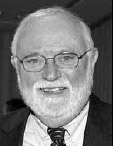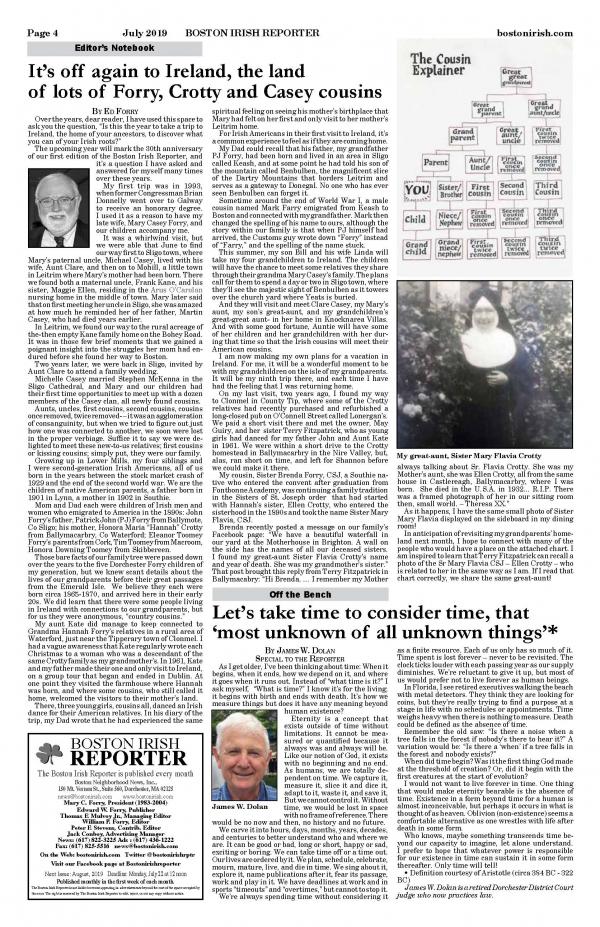
June 28, 2019

By Ed Forry
Over the years, dear reader, I have used this space to ask you the question, “Is this the year to take a trip to Ireland, the home of your ancestors, to discover what you can of your Irish roots?”
The upcoming year will mark the 30th anniversary of our first edition of the Boston Irish Reporter, and it’s a question I have asked and answered for myself many times over these years.
My first trip was in 1993, when former Congressman Brian Donnelly went over to Galway to receive an honorary degree. I used it as a reason to have my late wife, Mary Casey Forry, and our children accompany me.
It was a whirlwind visit, but we were able that June to find our way first to Sligo town, where Mary’s paternal uncle, Michael Casey, lived with his wife, Aunt Clare, and then on to Mohill, a little town in Leitrim where Mary’s mother had been born. There we found both a maternal uncle, Frank Kane, and his sister, Maggie Ellen, residing in the Arus O'Carolan nursing home in the middle of town. Mary later said that on first meeting her uncle in Sligo, she was amazed at how much he reminded her of her father, Martin Casey, who had died years earlier.
In Leitrim, we found our way to the rural acreage of the-then empty Kane family home on the Bohey Road. It was in those few brief moments that we gained a poignant insight into the struggles her mom had endured before she found her way to Boston.
Two years later, we were back in Sligo, invited by Aunt Clare to attend a family wedding.
Michelle Casey married Stephen McKenna in the Sligo Cathedral, and Mary and our children had their first time opportunities to meet up with a dozen members of the Casey clan, all newly found cousins.
Aunts, uncles, first cousins, second cousins, cousins once removed, twice removed- – it was an agglomeration of consanguinity, but when we tried to figure out just how one was connected to another, we soon were lost in the proper verbiage. Suffice it to say we were delighted to meet these new-to-us relatives; first cousins or kissing cousins, simply put, they were our family.
Growing up in Lower Mills, my four siblings and I were second-generation Irish Americans, all of us born in the years between the stock market crash of 1929 and the end of the second world war. We are the children of native American parents, a father born in 1901 in Lynn, a mother in 1902 in Southie.
Mom and Dad each were children of Irish men and women who emigrated to America in the 1890s: John Forry’s father, Patrick John (PJ) Forry from Ballymote, Co Sligo; his mother, Honora Maria “Hannah” Crotty from Ballymacarbry, Co Waterford; Eleanor Toomey Forry’s parents from Cork, Tim Toomey from Macroom, Honora Downing Toomey from Skibbereen.
Those bare facts of our family tree were passed down over the years to the five Dorchester Forry children of my generation, but we knew scant details about the lives of our grandparents before their great passages from the Emerald Isle. We believe they each were born circa 1865-1870, and arrived here in their early 20s. We did learn that there were some people living in Ireland with connections to our grandparents, but for us they were anonymous, “country cousins.”
My aunt Kate did manage to keep connected to Grandma Hannah Forry’s relatives in a rural area of Waterford, just near the Tipperary town of Clonmel. I had a vague awareness that Kate regularly wrote each Christmas to a woman who was a descendant of the same Crotty family as my grandmother’s. In 1961, Kate and my father made their one and only visit to Ireland, on a group tour that began and ended in Dublin. At one point they visited the farmhouse where Hannah was born, and where some cousins, who still called it home, welcomed the visitors to their mother’s land.
There, three young girls, cousins all, danced an Irish dance for their American relatives. In his diary of the trip, my Dad wrote that he had experienced the same spiritual feeling on seeing his mother’s birthplace that Mary had felt on her first and only visit to her mother’s Leitrim home.
For Irish Americans in their first visit to Ireland, it’s a common experience to feel as if they are coming home.
My Dad could recall that his father, my grandfather PJ Forry, had been born and lived in an area in Sligo called Keash, and at some point he had told his son of the mountain called Benbulben, the magnificent slice of the Dartry Mountains that borders Leitrim and serves as a gateway to Donegal. No one who has ever seen Benbulben can forget it.
Sometime around the end of World War I, a male cousin named Mark Farry emigrated from Keash to Boston and connected with my grandfather. Mark then changed the spelling of his name to ours, although the story within our family is that when PJ himself had arrived, the Customs guy wrote down “Forry” instead of “Farry,” and the spelling of the name stuck.
This summer, my son Bill and his wife Linda will take my four grandchildren to Ireland. The children will have the chance to meet some relatives they share through their grandma Mary Casey’s family. The plans call for them to spend a day or two in Sligo town, where they’ll see the majestic sight of Benbulben as it towers over the church yard where Yeats is buried.
And they will visit and meet Clare Casey, my Mary’s aunt, my son’s great-aunt, and my grandchildren’s great-great aunt- in her home in Knocknarea Villas. And with some good fortune, Auntie will have some of her children and her grandchildren with her during that time so that the Irish cousins will meet with their American cousins.
I am now making my own plans for a vacation in Ireland. For me, it will be a wonderful moment to be with my grandchildren on the isle of my grandparents. It will be my ninth trip there, and each time I have had the feeling that I was returning home.
On my last visit, two years ago, I found my way to Clonmel in County Tip, where some of the Crotty relatives had recently purchased and refurbished a long-closed pub on O’Connell Street called Lonergan’s. We paid a short visit there and met the owner, May Guiry, and her sister Terry Fitzpatrick, who as young girls had danced for my father John and Aunt Kate in 1961. We were within a short drive to the Crotty homestead in Ballymacarbry in the Nire Valley, but, alas, ran short on time, and left for Shannon before we could make it there.
My cousin, Sister Brenda Forry, CSJ, a Southie native who entered the convent after graduation from Fontbonne Academy, was continuing a family tradition in the Sisters of St. Joseph order that had started with Hannah’s sister, Ellen Crotty, who entered the sisterhood in the 1890s and took the name Sister Mary Flavia, CSJ.
Brenda recently posted a message on our family’s Facebook page: “We have a beautiful waterfall in our yard at the Motherhouse in Brighton. A wall on the side has the names of all our deceased sisters. I found my great-aunt Sister Flavia Crotty’s name and year of death. She was my grandmother’s sister.”
That post brought this reply from Terry Fitzpatrick in Ballymacabry: “Hi Brenda. … I remember my Mother always talking about Sr. Flavia Crotty. She was my Mother's aunt, she was Ellen Crotty, all from the same house in Castlereagh, Ballymacarbry, where I was born. She died in the U.S.A. in 1932... R.I.P. There was a framed photograph of her in our sitting room then, small world. – Theresa XX.”
As it happens, I have the same small photo of Sister Mary Flavia displayed on the sideboard in my dining room!
In anticipation of revisiting my grandparents' homeland next month, I hope to connect with many of the people who would have a place on the attached chart. I am inspired to learn that Terry Fitzpatrick can recall a photo of the Sr Mary Flavia CSJ – Ellen Crotty – who is related to her in the same way as I am. If I read that chart correctly, we share the same great-aunt!

